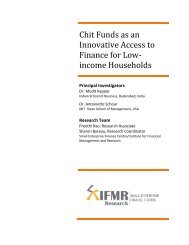Government of India Volume I: Analysis and Recommendations
Government of India Volume I: Analysis and Recommendations
Government of India Volume I: Analysis and Recommendations
You also want an ePaper? Increase the reach of your titles
YUMPU automatically turns print PDFs into web optimized ePapers that Google loves.
CHAPTER 14<br />
Financial regulatory architecture<br />
We now turn to the financial regulatory architecture, or the division <strong>of</strong> the overall work <strong>of</strong><br />
financial regulation across a set <strong>of</strong> regulatory agencies. In the international experience,<br />
there are three main choices (Table 14.1): A single financial regulator; a ‘twin peaks model’,<br />
where one agency focuses on consumer protection <strong>and</strong> the other on micro-prudential<br />
regulation; <strong>and</strong> a fragmented approach, where there are multiple agencies.<br />
14.1. Financial regulatory architecture as a distinct feature <strong>of</strong><br />
financial law<br />
Many alternative structures can be envisioned for the financial regulatory architecture.<br />
Parliament must evaluate alternative block diagrams through which a suitable group <strong>of</strong><br />
statutory agencies is h<strong>and</strong>ed out the work associated with the law. These decisions could<br />
conceivably change over the years.<br />
At present, <strong>India</strong>n law features tight connections between a particular agency (e.g.<br />
SEBI) <strong>and</strong> the functions that it performs (e.g. securities regulation). The draft Code does<br />
not provide for such integration. This is to ensure that from the outset, <strong>and</strong> over coming<br />
decades, decisions about the legal framework governing finance can proceed separately<br />
from decisions about the financial regulatory architecture. Changes in the work allocation<br />
<strong>of</strong> agencies would not require changes to the underlying law itself. This will yield<br />
greater legal certainty, while facilitating rational choices about financial regulatory architecture<br />
motivated by considerations in public administration <strong>and</strong> public economics.<br />
Table <strong>of</strong> <strong>Recommendations</strong> 14.1 Alternative structures<br />
Single regulator<br />
All financial regulation can be placed with one agency. In this case, this one agency will enforce microprudential<br />
<strong>and</strong> consumer protection provisions in the draft Code for all financial activities.<br />
Twin peaks<br />
Some countries have constructed two regulators: one focused on micro-prudential regulation <strong>and</strong> the other<br />
on consumer protection.<br />
Complex structures<br />
The US has a highly fragmented regulatory model. As an example, the Commodities Futures Trading Commission<br />
(CFTC) regulates derivatives trading, while the U.S. Securities <strong>and</strong> Exchange Commission (SEC) regulates<br />
the spot market. The US also has state level regulators in some areas.<br />
FINANCIAL SECTOR LEGISLATIVE REFORMS COMMISSION 131



